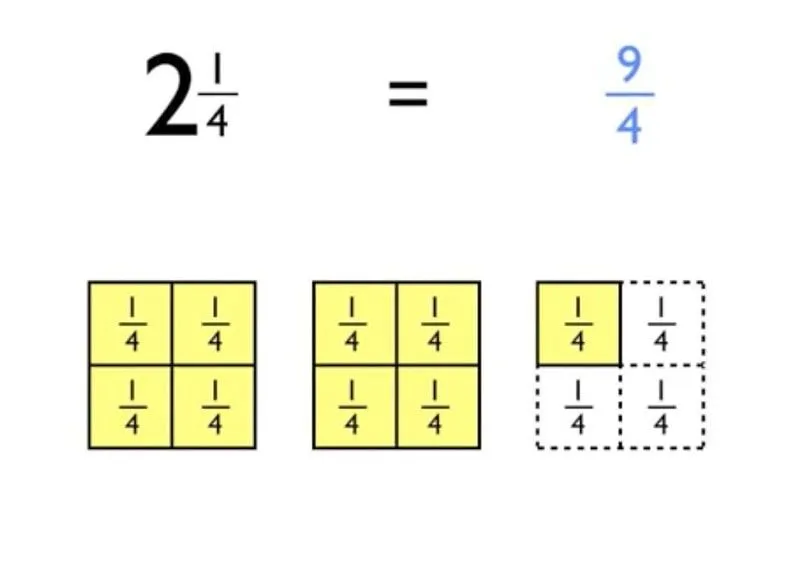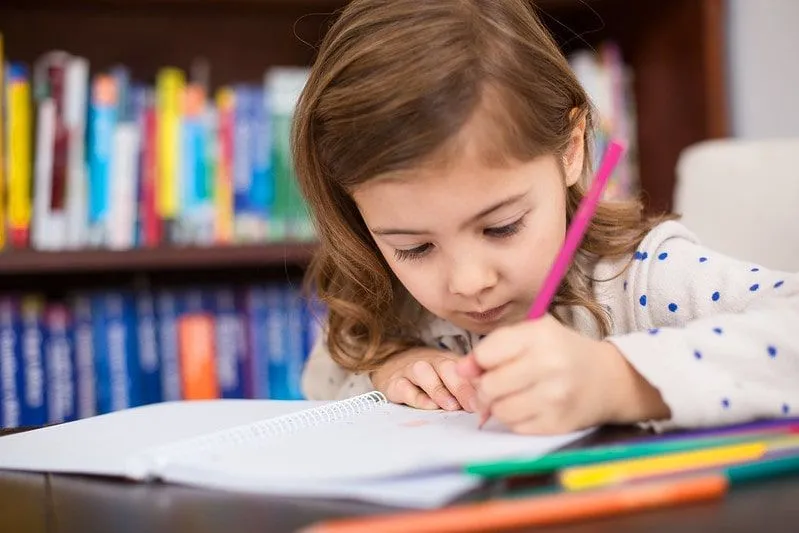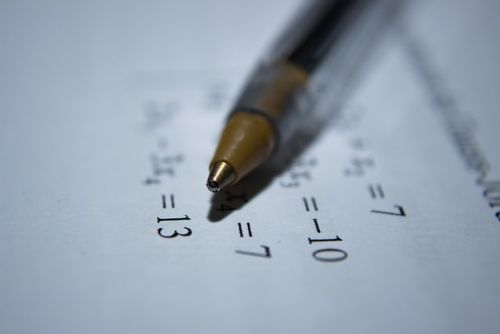FOR AGES 7 YEARS TO 11 YEARS
Image © Santi Vedri.
An improper fraction is a fraction where the numerator (top part of the fraction) is bigger than the denominator (bottom part of the fraction).
It's an improper fraction because the proper fractions that we're used to have a smaller numerator and larger denominator. You might know it as a top-heavy fraction, which makes perfect sense because the top is bigger (heavier) than the bottom.
A mixed number is a whole number (a number without a decimal point, like 4) and a fraction (like 2/3) put together. Mixing numbers and fractions may seem odd, but it's actually preferred to the improper fraction.
For Example:
-'Three and a half' would look like this: 3 1/2 (this is not 31/2!).
-'One and one fifth' would look like this: 1 1/5.
-'Two and three-quarters' would look like this: 2 3/4.
To Convert Improper Fractions To Mixed Numbers, Ask These Two Questions:
1) How many times does the bottom of the fraction (the denominator) go into the top (the numerator)?
2) What is the remainder?
The answer to the first question will give you your whole number, and the answer to the second question will give you the numerator for the fraction that will go with it.
For Example:
-14/5 = 2 4/5
5 goes into 14 two times, as you can fit two 5s into 14. This means your whole number will be 2 and your remainder will be 4.
Or, 14/5 = 2 r 4.
So, 14/5 as a mixed number would be 2 4/5 (not 24/5, there's a space!).
-23/4 as a mixed number is 5 3/4.
-3/2 as a mixed number is 1 1/2.

Image © MathsMaster.org
KS2 children will need to be able to turn improper fractions into mixed numbers, and mixed numbers back into improper fractions. Here's how to do it the other way around:
1) Multiply your whole by your denominator.
2) Add your answer to step one to the numerator.
Voila! You take your whole, times by the bottom and add it to the top.
For Example:
-1 2/3 as an improper fraction is 5/3.
-5 3/4 as an improper fraction is 23/4.
-2 11/12 as an improper fraction is 35/12.
-Improper fractions are fractions with a bigger number on top and a smaller number on the bottom.
-A proper fraction is the opposite: smaller on top and bigger at the bottom.
-An improper fraction is also known as a top-heavy fraction.
-A mixed number is a whole number mixed with a fraction.
-In maths, mixed numbers are preferred to improper fractions.
-To convert improper fractions to mixed numbers: find how many times your denominator goes into your numerator completely (your whole) and find the remainder. The whole will go next to the fraction, on the left, and the remainder will be the numerator of your new fraction.
-To convert the other way around: multiply your whole by the denominator, then add the numerator to get an improper fraction again.
Conversions between mixed numbers and improper fractions begin in Year 5, though the concept of mixed numbers is introduced in Year 2.
Year 2: Children learn to count in fractions up to 10, recognising that fractions can be greater than one.
Year 3: Children become more familiar with mixed numbers and the fact that fractions can be greater than one.
Year 4: Children become more experienced with mixed numbers and the fact that fractions can be greater than one.
Year 5: Children begin to recognise the equivalence between mixed numbers and improper fractions; learning how to convert between them either way.
Year 6: Children develop more confidence as they recognise the equivalence between mixed numbers and improper fractions; they can also convert between them more fluently.

There are loads of real-life applications of improper fractions to help you help the kids get to grips with it. Here are some examples:
-"If I have two packets of biscuits and I eat half a packet, how much do I have left? How many halves is that?"
-"Here are three whole sandwiches, each cut into quarters. If I eat just one quarter, how many quarters will be left?"
-"Here is a cake, cut into eight pieces. How many eighths are in a whole? If I bought another cake and cut it into eighths, how many eighths would there be in two whole cakes? If I ate a slice, how many eights would there be left?"
And in each of these examples, there's plenty of opportunity for some hands-on engagement!
Get Cooking: Why not make homemade pizzas from scratch? The process of slicing and inevitable conversation about fractions will come naturally. Other foods you can work with are chocolate bars and cut fruit!
Get Building: Grab some Lego and discuss improper fractions, as you work out how many of the flatter pieces need to be connected to be the same height as a regular block. Then, split up and try to build the same thing (like a wall to protect a toy car): one of you only uses regular blocks and the other only uses the flatter ones. Or learn about fractions while building a sweet dispenser.
Get Baking: Bake some cakes and slice away! Why not be creative with the flavour too?
Read The Disclaimer
At Kidadl we pride ourselves on offering families original ideas to make the most of time spent together at home or out and about, wherever you are in the world. We strive to recommend the very best things that are suggested by our community and are things we would do ourselves - our aim is to be the trusted friend to parents.
We try our very best, but cannot guarantee perfection. We will always aim to give you accurate information at the date of publication - however, information does change, so it’s important you do your own research, double-check and make the decision that is right for your family.
Kidadl provides inspiration to entertain and educate your children. We recognise that not all activities and ideas are appropriate and suitable for all children and families or in all circumstances. Our recommended activities are based on age but these are a guide. We recommend that these ideas are used as inspiration, that ideas are undertaken with appropriate adult supervision, and that each adult uses their own discretion and knowledge of their children to consider the safety and suitability.
Kidadl cannot accept liability for the execution of these ideas, and parental supervision is advised at all times, as safety is paramount. Anyone using the information provided by Kidadl does so at their own risk and we can not accept liability if things go wrong.
Kidadl is independent and to make our service free to you the reader we are supported by advertising.
We hope you love our recommendations for products and services! What we suggest is selected independently by the Kidadl team. If you purchase using the buy now button we may earn a small commission. This does not influence our choices. Please note: prices are correct and items are available at the time the article was published.
Kidadl has a number of affiliate partners that we work with including Amazon. Please note that Kidadl is a participant in the Amazon Services LLC Associates Program, an affiliate advertising program designed to provide a means for sites to earn advertising fees by advertising and linking to amazon.
We also link to other websites, but are not responsible for their content.
Was this article helpful?



Browse Category



We’ll send you tons of inspiration to help you find a hidden gem in your local area or plan a big day out.



Check your inbox for your latest news from us. You have subscribed to:
Remember that you can always manage your preferences or unsubscribe through the link at the foot of each newsletter.